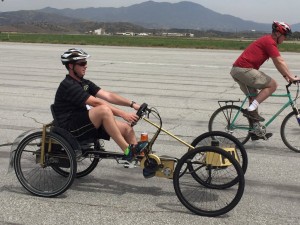 This week, I had the good fortune to attend the Chainless Challenge, one of the most creative design competitions you’re likely to find. A decade ago, some Parker Hannifin engineers came up with the idea of challenging college engineering students to design a hydraulic bicycle. Basically, students have to strip the chain drive off a typical bicycle and design a hydraulic system that takes the torque generated from pedaling the bike and transmits it to the wheel(s).
This week, I had the good fortune to attend the Chainless Challenge, one of the most creative design competitions you’re likely to find. A decade ago, some Parker Hannifin engineers came up with the idea of challenging college engineering students to design a hydraulic bicycle. Basically, students have to strip the chain drive off a typical bicycle and design a hydraulic system that takes the torque generated from pedaling the bike and transmits it to the wheel(s).
The Challenge, which started in Parker’s hometown of Cleveland, eventually migrated to Southern California, where it’s held each Spring on the old runways of the decommissioned El Toro Marine Corps Air Station. This year’s Challenge included teams from eight universities: Cal Poly/San Luis Obispo, Cleveland State University, Illinois Institute of Technology, Purdue University, University of Akron, University of Cincinnati, University of Illinois/Urbana, and Western Michigan University.
The Challenge is undergoing a big change, however—the National Fluid Power Association is taking over the reins of the event from Parker next year. Parker has been extremely generous with the Challenge, paying all of students’ travel costs, not to mention providing components for the actual bicycle builds. The NFPA staff is excited about the future prospects.
“I think this program has a lot of potential for growth and my being here to witness it firsthand has really demonstrated—as we talk to the different professors and students—this is a really viable way of getting fluid power instruction into mechanical engineering curriculums,” said Eric Lanke, NFPA’s CEO. “We think that’s where the scalability issue is going to be most focused. We’re going to be investing our resources to not just organize [the Challenge] but to help it grow, to get more and more schools involved in this activity.”
I hope Parker stays actively involved, but I’d also love to see other manufacturers step up and offer their support (including donating components) to these kids. Maybe a few fluid power distributors can get involved, too. Who’s up to the Challenge of helping this worthwhile program?
I hear a continual stream of comments in our industry that we need to increase the amount of engineers graduating from college who know fluid power. Here’s a real way that we can do just that. Getting these kinds of college students excited about fluid power means there will be that many more potential hires in the coming years. And that’s a challenge we all have to address.


Would like to know the mechanics if available just to see how hydraulic pedal power drives the tri-cycal.
Melvyn R. (Mel) Tichy
My family has been in the global plumbing business for over 150 years. Any project, first needs good trained people. I recommend that you contact the business agent of your “Plumbers Union.” trade school for practical technical support. You can earn an Engineering Degree in four years, but it takes five years of education, and
training, to become a Plumber. Remember, those people protect the health; of this great nation.
Sample amounts of fluids can also be provided by local oil company s.
I had not previously considered the possibility of a hydraulic drive bike. But it certainly offers some very interesting options, but light weight is not one of them that I see. The chance to include a small gas engine to drive a pump could certainly simplify adding an engine drive to a regular bike, and a variable displacement motor could make the whole package a great mountain bike. So now I need to do some research and thinking.
How about posting pictures and descriptions of those bikes already build?